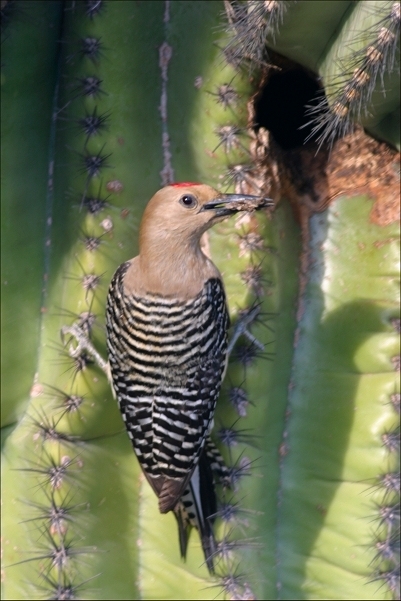Desert birds (Ecology)
Contents
- 1 Desert birds
- 1.1 Challenges of desert life
- 1.2 Resident desert birds
- 1.3 References and Further Reading
Desert birds
Deserts are challenging environments. Any organism that makes the desert its home must be able to cope with extreme temperatures and a scarce supply of water. Birds have the obvious advantage of flight which allows many of them to be only temporary visitors stopping off along their migrations, or seasonal inhabitants sticking around to breed during the more favorable seasons and leaving when things get too rough. There are a limited number of bird species that can truly call themselves desert dwellers, living primarily or only in such arid environments and not migrating. These birds possess some fascinating adaptations for dealing with life in the desert. (see: Adaptations of desert birds and mammals)
Challenges of desert life
Organisms living in desert environments face several challenges including (1) obtaining and retaining water, (2) regulating their body temperature, and (3) obtaining and conserving energy.
Obtaining water
Some birds are able to derive all the water they need from their food, especially those with carnivorous habits. However, other birds, such as granivores who consume dry seeds, must drink, in order to take up water.
Conserving water
Because water is in short supply in deserts, birds who live there have been selected to conserve water. Like all animals, birds must eliminate waste products, so water is lost from the body during the elimination process. All birds are able to avoid wasting water in the excretion of metabolic wastes by reabsorbing water from feces before excretion, resulting in the production of a highly concentrated fecal paste of uric acid.
Thermal regulation
Poikilothermic organisms such as amphibians and reptiles rely on the heat of the environment to warm their bodies. Endothermic animals, such as birds and mammals, use energy to keep their body temperatures above that of the environment. Thus, these endothermic species may be at especially great risks of overheating when environmental temperatures are high.
Heat avoidance
Limiting activity and avoiding direct sunlight are helpful strategies for limiting heat gain. Many birds are crepuscular, limiting their activity to dawn and dusk, and spending most of the day in the shade. Turkey vultures escape the heat by soaring on Thermals of cooler air. A hummingbird, representing the alternative extreme, needs to feed almost constantly to maintain its racing metabolism. At night, when it is inactive, rather than expending energy trying to keep warm, it is able to enter a state of temporary hibernation.
Heat dissipation
Birds such as owls, poorwills and nighthawks that attain a good supply of water from prey (Predation) are able to dissipate heat byevaporative cooling. These species open their mouths wide and flutter their throat region to evaporate water from their mouth cavities. A Turkey vulture dissipates hear through a much more disturbing behavior, urinating on its legs and then circulating the cooled blood back through its body.
Obtaining and conserving energy
Because rates of photosynthesis can be limited by moisture availability, the primary productivity of desert environments is low. Thus, less energy flows through the desert food chains than in more productive environments which limits the amount of energy available for consumers to eat. Moreover, most desert organisms are well protected from predators by chemical or physical means. Desert organisms have evolved a number of foraging strategies to allow them to obtain energy in an unproductive environment filled with well-defended prey.
After an animal has consumed a prey it wants to do everything possible to conserve the energy it has just gained. Organisms can reduce their energy use by remaining inactive or even by slowing their metabolic rate.
Resident desert birds
Many birds avoid the problems of living in desert environments by leaving the desert during the harshest conditions. However, some birds are year round residents of the desert and have therefore evolved adaptations to arid climates. The following desert residents demonstrate some of the variety of strategies that birds have evolved to allow them to cope with the challenges of living in desert environments.
North American deserts
There are four main deserts in North America, the Sonoran Desert, the Chihuahuan Desert, Mojave Desert, and the Great Basin Desert (see: Deserts of North America). The following birds are common residents of some North American deserts.
Greater Roadrunner (Geococcyx californianus)
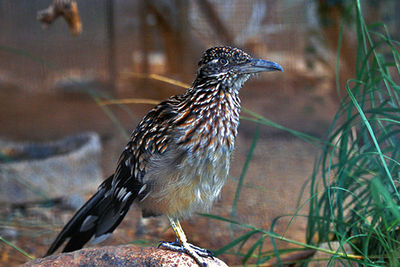 Greater Roadrunner (Geococcyx californianus). Photo by Peter Wallack (Own work) (http://creativecommons.org/licenses/by-sa/3.0) or GFDL (http://www.gnu.org/copyleft/fdl.html), via Wikimedia Commons One of the most notable desert birds in North America is the roadrunner. Roadfunners, known for their preference for running over flying, are capable of reaching speeds of up to 17 miles per hour. They are able to catch and eat rattlesnakes, sometimes going about their business with a snake still dangling from their mouths as it is slowly digested. The Greater Roadrunner is found throughout the Mojave, Sonoran, Chihuahuan, and southern Great Basin Deserts, in all the southwestern U.S. and south as far as central Mexico. The combination of the harsh desert environment and the inability of the roadrunner to fly for extended periods of time have put considerable selective pressure on this bird for traits that have allowed it to take up permanent residency.
Greater Roadrunner (Geococcyx californianus). Photo by Peter Wallack (Own work) (http://creativecommons.org/licenses/by-sa/3.0) or GFDL (http://www.gnu.org/copyleft/fdl.html), via Wikimedia Commons One of the most notable desert birds in North America is the roadrunner. Roadfunners, known for their preference for running over flying, are capable of reaching speeds of up to 17 miles per hour. They are able to catch and eat rattlesnakes, sometimes going about their business with a snake still dangling from their mouths as it is slowly digested. The Greater Roadrunner is found throughout the Mojave, Sonoran, Chihuahuan, and southern Great Basin Deserts, in all the southwestern U.S. and south as far as central Mexico. The combination of the harsh desert environment and the inability of the roadrunner to fly for extended periods of time have put considerable selective pressure on this bird for traits that have allowed it to take up permanent residency.
Adaptations for desert life
The roadrunner has a few tricks up its plumage when it comes to facing the challenges of desert living. The roadrunner’s moisture-rich diet is made up almost exclusively of other animals, including insects, scorpions, lizards, snakes, rodents and other birds, although up to ten percent of its diet during the winter months may consist of plant material. On top of its ability to excrete highly concentrated waste, the roadrunner has a special nasal gland that eliminates excess salt. In order to avoid heat, it reduces its activity 50% during the heat of midday, and it is able to conserve energy through hypothermia and solar (Sunlight) absorption. The roadrunner is one of the largest birds known to enter a hypothermic state at night. Its dorsal skin is black, so on a cool morning the roadrunner will put its back to the sun and ruffle its feathers out so that the sun can hit the dark skin and then heat is quickly absorbed without any unnecessary expenditure of metabolic energy.
Gila Woodpecker (Melanerpes uropygialis)
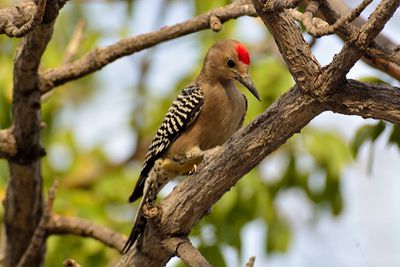 Gila Woodpecker (Melanerpes uropygialis). Photo by Octavio Telis (Own work) (http://creativecommons.org/licenses/by-sa/3.0), via Wikimedia Commons The Gila Woodpecker is another bird who can claim the desert as its permanent home. Like all woodpeckers, its body is uniquely adapted for pecking, though unlike its relatives, it survives in an environment lacking in wood to peck. Though it has been able to take advantage of trees along river bottoms, in pygmy forests along lower mountain slopes and in urban neighborhoods, it is best known for making use of the saguaro and other large cacti, and so its range is closely associated with them. Gila Woodpeckers are found primarily in Arizona’s Sonoran Desert, the southeastern tip of California, the southwestern corner of New Mexico and southward into west-central Mexico.
Gila Woodpecker (Melanerpes uropygialis). Photo by Octavio Telis (Own work) (http://creativecommons.org/licenses/by-sa/3.0), via Wikimedia Commons The Gila Woodpecker is another bird who can claim the desert as its permanent home. Like all woodpeckers, its body is uniquely adapted for pecking, though unlike its relatives, it survives in an environment lacking in wood to peck. Though it has been able to take advantage of trees along river bottoms, in pygmy forests along lower mountain slopes and in urban neighborhoods, it is best known for making use of the saguaro and other large cacti, and so its range is closely associated with them. Gila Woodpeckers are found primarily in Arizona’s Sonoran Desert, the southeastern tip of California, the southwestern corner of New Mexico and southward into west-central Mexico.
Adaptations to desert life
As the Gila Woodpecker doesn’t display the kind of desert specific physiological traits seen in the roadrunner, its ability to survive in the desert can be chalked up to its ability to create its nest cavity, where temperature is moderated year round. A mating pair excavates a saguaro and then leaves it alone for several months to dry, allowing the inner pulp to form a solid casing, before returning to raise a family.
Costa’s Hummingbird (Calypte costae)
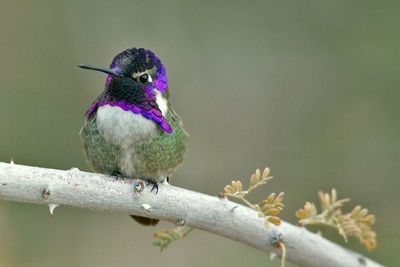 Calypte costae, Costa's Hummingbird (Male), Visitor's Center, Anza Borrego Desert State Park, Borrego Springs, California (By Alan D. Wilson (NaturesPicsOnline) (http://creativecommons.org/licenses/by-sa/2.5), via Wikimedia Commons) Though many species of hummingbirds make a temporary stay in the desert as they stop off along their migrations, the Costa’s Hummingbird is the closest to being a true desert hummingbird. It breeds in the Sonoran and Mojave Deserts of California and Arizona, departing a short distance to chaparral, scrub, or woodland habitat on the edge of the desert for the hottest days of summer.
Calypte costae, Costa's Hummingbird (Male), Visitor's Center, Anza Borrego Desert State Park, Borrego Springs, California (By Alan D. Wilson (NaturesPicsOnline) (http://creativecommons.org/licenses/by-sa/2.5), via Wikimedia Commons) Though many species of hummingbirds make a temporary stay in the desert as they stop off along their migrations, the Costa’s Hummingbird is the closest to being a true desert hummingbird. It breeds in the Sonoran and Mojave Deserts of California and Arizona, departing a short distance to chaparral, scrub, or woodland habitat on the edge of the desert for the hottest days of summer.
Adaptations to desert life
Hummingbirds have body temperatures that range from 105 to 109 °Fahrenheit, so they are able to conduct heat to the environment up to these high temperatures. Because they are so active andthey have such a small capacity for storing energy they constantly have to refuel. On cold nights, it may take too much energy just to keep warm, so a hummingbird will ruffle its feathers to let body heat escape until it becomes torpid, allowing its body temperature to fall to a level near the ambient surroundings. A torpid Costa’s Hummingbird’s heart beats about 50 times per minute, with slower than its normal resting heart rate of 500 to 900 beats per minute. This behavior allows the hummingbird to conserve energy and water, as moisture is lost with every breath.
Turkey Vulture (Cathartes aura)
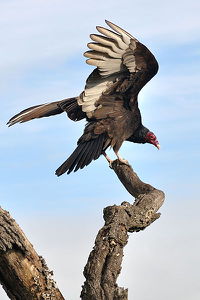 An adult Turkey Vulture at Santa Teresa County Park, San Jose, California, USA. Photo by Don DeBold from San Jose, CA, USA [CC-BY-2.0], via Wikimedia Commons For many people, the image of circling vultures is a familiar symbol of death, and though the vulture is known for feeding on dead animal carcasses, its circling may not always indicate the presence of death. It may simply indicate the presence of rising air on a hot day. A Turkey Vulture may circle on a thermal to cool off and to conserve energy. It can go days between meals, so it burns as little energy as possible while searching for food, often soaring with scarcely a flap of the wings, simply rocking back and forth with its wings spread in a v-shape. The Turkey Vulture range extends across almost the entire U.S. and as far south as the southern tip of South America, spanning a number of deserts, which it is well adapted for.
An adult Turkey Vulture at Santa Teresa County Park, San Jose, California, USA. Photo by Don DeBold from San Jose, CA, USA [CC-BY-2.0], via Wikimedia Commons For many people, the image of circling vultures is a familiar symbol of death, and though the vulture is known for feeding on dead animal carcasses, its circling may not always indicate the presence of death. It may simply indicate the presence of rising air on a hot day. A Turkey Vulture may circle on a thermal to cool off and to conserve energy. It can go days between meals, so it burns as little energy as possible while searching for food, often soaring with scarcely a flap of the wings, simply rocking back and forth with its wings spread in a v-shape. The Turkey Vulture range extends across almost the entire U.S. and as far south as the southern tip of South America, spanning a number of deserts, which it is well adapted for.
Adaptations to desert life
It is able to obtain much of its water needs from the moisture in the carrion it feeds on and its specialized kidneys enable it to excrete less water when expelling waste products. Though considered ugly by some, its bald head is much more practical than a feathered one when it comes time to clean up after a meal. Perhaps even more interesting and more unpleasant than its table manners or hairstyle, is its unique method of thermoregulation, called urohydrosis. A Turkey Vulture cools off by urinating on its legs, and circulating the blood cooled by the evaporation of excrement back through the rest of its body. A Turkey Vulture with white legs gives its secret away, as its legs are normally red.
References and Further Reading
- Arizona-Sonora Desert Museum. Birds.
- Cornell Lab of Ornithology. Bird guide.
- DesertUSA.com. Desert Animals and Wildlife.
- The Desert Adaptations of Birds & Mammals, Arizona-Sonora Desert Museum.
- Desert Animal Survival, Desert USA.
- Phillips, S.J. and P.W. Comus (eds.) 2000. A Natural History of the Sonoran Desert. Arizona-Sonora Desert Museum Press, Tucson, and University of California Press, Berkeley.
This article was partially researched by a student at Texas Tech University participating in the Encyclopedia of Earth's Student Science Communication Project. The project encourages students in undergraduate and graduate programs to analyze timely scientific issues under close faculty guidance. All articles have been reviewed by internal EoE editors, and by independent experts on each topic.
